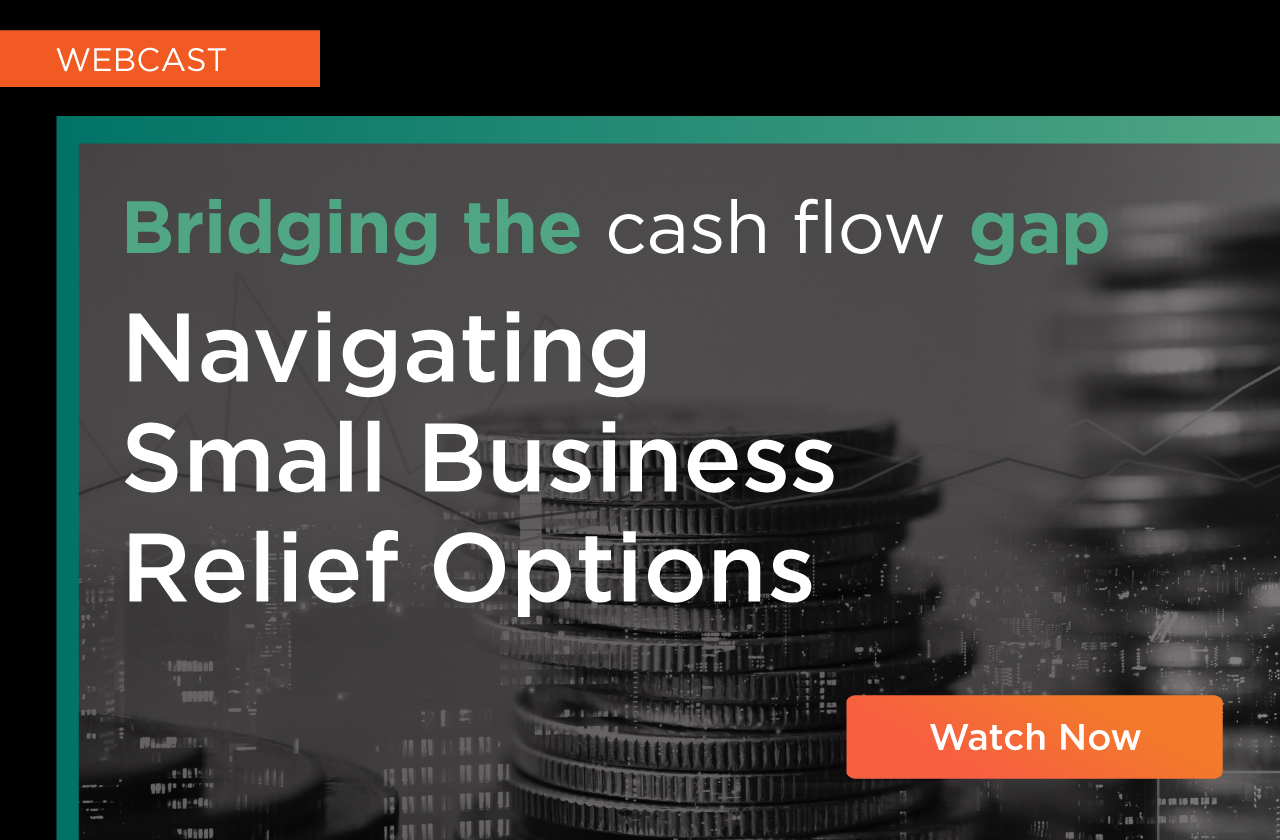Paycheck Protection Program Loans - New Guidance Issued: What Small and Medium Size Businesses Need to Know

Table of contents
- 1.New Paycheck Protection Program Loan Guidance:
On March 27, 2020, the U.S. government launched its small-business relief program as part of the recently enacted CARES Act. The Act provides $2.2 trillion in fiscal stimulus, including a $350 billion Paycheck Protection Program (PPP) for small businesses.
For small and medium size businesses (SMBs), the PPP is a critical provision of the CARES Act and is administered by the Small Business Administration (SBA). It is designed to help businesses cover payroll costs and other expenses from February 15, 2020 through June 30, 2020.
SMBs must ensure they have the most up-to-date information as new guidance is coming out regularly and we expect more to come. Small businesses need to exercise one of the greatest advantages they have, which is to be nimble and pivot as changes are announced.
Our recently hosted webinar, in collaboration with Fisher Phillips, a leading labor and employment firm, discusses pressing issues that SMBs need to think about in order to maximize their ability to bridge the cash flow gap.

We are continuing to monitor the COVID-19 situation and will update you on the impact of changing regulations on SMBs through our blogs and webinar series.
New Paycheck Protection Program Loan Guidance:
The IRS issued major new guidance on Friday, April 10, 2020, that all SMBs applying for a PPP loan should know about. Specifically, under this new guidance an employer may apply for and receive a PPP loan while at the same time electing to defer Social Security taxes under the CARES Act without incurring penalties for failure to deposit or pay Social Security taxes. There is a big, caveat: once the employer receives notice from its lender that the loan has been forgiven, the employer must stop deferring their Social Security tax payments. The amount deferred through the loan forgiveness date continues to be deferred and will be due on the applicable due dates. On December 31, 2021, 50 % of the deferred amount is due and on December 31, 2022, the remaining amount is due.
Employers may also elect to defer Social Security taxes under the CARES Act while at the same time claiming paid leave tax credits under the Families First Coronavirus Relief Act, or claiming the employee retention credit under the CARES Act, and prior to determining the amount of employment tax deposits that it may retain in anticipation of these credits, the amount of any advance payments of these credits, or the amount of any refunds with respect to these credits.
To further help understand the PPP loan program, below are some of the most frequently asked questions we are hearing from our SMB clients.
Question: I’ve heard there are other forms of relief available to SMBs in addition to the SBA loan.
Answer: Yes, the CARES Act has several provisions intended to help employers keep their employees on payroll. We have outlined to key programs below. We recommend you speak to your accountant or financial advisor to determine the best decision for your company. If you are a TriNet client, we will be able to process the retention tax credit and social security tax deferral for you. Please keep in mind that if you take the Employee Retention Tax Credit you will not be able to obtain a PPP loan from the SBA. In addition, once all or part of your PPP loan is forgiven, you can no longer defer Social Security taxes under the CARES Act.
- Employee Retention Tax Credit: This allows employers (regardless of size) that are uniquely affected by COVID-19 to claim a refundable tax credit. The credit is taken against the employer portion of payroll tax equal to 50% of certain wages paid to employees between March 13, 2020, through the end of the year. Only $10,000 of wages can be taken into account for any employee. This 50% credit is available to businesses that:
- Social Security Tax Deferral: Another provision available to employers of all sizes is the ability to defer the payment of the employer portion of Social Security taxes (6.2% of wages) for the remainder of 2020. Fifty percent of the deferred taxes must be repaid by the end of 2021, and the remainder is due by the end of 2022.
- It is very important to remember:
- If you have a new SBA loan, you cannot claim the 50% retention tax credit.
- Once you have a new SBA loan forgiven, you must stop all Social Security tax deferrals under the CARES Act.
- If you claim the 50% employee retention credit, you cannot obtain a new SBA loan.
You can only use the Social Security tax deferral until the date on which all or part of your PPP loan is forgiven.
Question: How do I access the SBA loan application?
Answer: The application can be found on the U.S. Department of Treasury website. The site also provides important guidance and FAQs every borrower should review before applying. The deadline to apply is June 30, 2020.
Question: What type of payroll documents do I need to apply?
Answer: You will need to submit documents that verify:
- you had employees
- you paid wages and taxes
- your average monthly payroll
TriNet clients should visit the clientmicrosite which includes instructions as to how to simply access this information for your company.
Question: For the purpose of determining the loan amount for which I am eligible, how are payroll costs defined?
Answer: The SBA and Treasury recently released FAQs clarifying how to calculate average monthly payroll costs. It is now clear that there is no reduction for the employee’s federal income tax and employment tax liability. The FAQs further clarified that payments to independent contractors are not payroll costs and that employers can calculate average payroll costs using data either from the previous 12 months or from calendar year 2019. The FAQs were not released until late Monday night, April 6, by which time many employers may have filed their applications. According to the FAQs, employers who filed an application before the new FAQs may rely on prior guidance and do not have to revise their applications. Employers may wish to contact their bank to supplement their application based on this new guidance.
Payroll costs include:
- Salary, wage, commission or similar compensation capped at $100,000 per employee
- Cash tips or equivalent
- Pay for vacation, parental, family, medical or sick leave
- Payments for dismissal or separation
- Employer contributions for group health care benefits, including insurance premiums
- Employer contributions to retirement plans
- State or local tax assessed on the compensation of employees
Payroll costs do not include:
- Sick and family leave wages for which a credit is allowed under the Families First Coronavirus Act
- Payments made to independent contractors
- Employer paid federal payroll taxes
Question: For the purpose of determining eligibility for the SBA loan, does the size of my company matter?
Answer: Yes. For purposes of a PPP loan, small employers under 500 (these are for- profit companies that operate in the US) are eligible for a PPP loan (“small business concerns”). The law also says that any business, non-profit, veteran’s organization or tribal business shall be eligible to receive a covered loan if that entity employs not more than the greater of 500 employees or the number of employees allowed by the employee-based size standard applicable to that entity. Certain businesses in the lodging and food services industry can qualify so long as they employ no more than 500 employees at each location.
Question: I’ve heard that size matters, but also that counting to 500 is complicated, why is that?
Answer: You may not be a small employer with under 500 employees if you have an affiliation with another company. This has been particularly concerning to many startup companies who have asked if they qualify or whether the venture capital or private equity firms that have invested in them will disqualify them since these businesses often invest in many companies at one time.
A lot of the confusion with regard to the affiliation concept came about because of two rules governing affiliation for the purposes of SBA programs with very similar section numbers: 13 CFR 121.103 (not the right rule for this analysis but the rule on which a lot of early analysis focused) and 13 CFR 121.301 (the correct rule for an analysis on ‘affiliation’ for a PPP loan).
Section 121.301 requires you to ask three key questions with respect to the issue of equity holder control:
- Does a single stockholder holder more than 50% of the equity in your company?
- Does a single stockholder control a majority of your company’s board?
- Does a single stockholder have the ability to block certain or any corporate actions leading to control in practice even if not by ownership or board seat (you will need to review your company’s foundation documents to answer this question).
If your answer to any of these questions is yes, you should review with your company counsel and your stockholder, because you may need to include all of that stockholder’s headcount, together with headcount of other investments of the same stockholder, in your headcount analysis.
Question: What about employees outside the US? Do they count in my 500?
Answer: As mentioned above, the correct rule for determining ‘affiliation’ for the purposes of a PPP loan is 13 CFR 121.301. Section 121.301 provides that in determining size of your company all domestic and foreign affiliates should be included (regardless of whether they are organized for profit). This would require all employees regardless of where located, to be counted.
However, the FAQ issued by the SBA On April 6, 2020, reflected language that was included in previous SBA guidance which stated that a company is “eligible for a PPP loan if you have 500 or fewer employees whose principal place of residence is in the United States.” Which suggests that you need not count employees who maintain their principal residence outside the United States when applying affiliation rules.
This could lead to what might appear to be unintended results, and as such TriNet continues to monitor for additional guidance on this point.
Question: Is there anything else I should know about counting to 500?
Answer: Yes, here are a few more tips:
- Size is determined during the covered period which is February 15 through June 30, 2020.
- Businesses with more than 500 employees are eligible in certain circumstances if they meet SBS employee-based size standards for certain industries.
- See the U.S. Treasury Department’s instructions and other FAQs including affiliation rules.
Question: Once I receive the loan, should I rehire my employees or bring back furloughed employees?
Answer: The CARES Act is designed to provide an incentive to employers to rehire or not lay off workers and instead use the loan amounts to pay payroll and certain other operating expenses for the eight-week period after the loan. The federal government will forgive the loans in an amount equal to the amount of qualifying costs spent during an eight-week period after the origination of the loan. Any reduction in the amount of loan forgiveness (see below) will be completely avoided if the employer re-hires all employees laid off (going back to February 15, 2020) or increases their previously reduced wages, no later than June 30, 2020. It is critical to remember that not more than 25 percent of the forgiven amount may be for non-payroll costs.
Follow TriNet’s COVID-19 Business Resiliency andPreparedness Center for critical up-to-date information on changing regulations and their impact on small and medium size businesses.
This communication is for informational purposes only; it is not legal, tax or accounting advice; and is not an offer to sell, buy or procure insurance.
This post may contain hyperlinks to websites operated by parties other than TriNet. Such hyperlinks are provided for reference only. TriNet does not control such websites and is not responsible for their content. Inclusion of such hyperlinks on TriNet.com does not necessarily imply any endorsement of the material on such websites or association with their operators.

Samantha Wellington
Table of contents
- 1.New Paycheck Protection Program Loan Guidance:





